Bidzina Ivanishvili: “In basically every agricultural field, output has increased threefold and more than threefold.”
Verdict: Bidzina Ivanishvili’s statement is FALSE.
Resume: In order to assess the situation in agriculture in general, it is appropriate to analyse agriculture’s real growth rate (how sector output changed excluding the impact of price difference) and ratio of agriculture to the entire Georgian economy; that is, the agriculture to the GDP ratio. In 2019, real agriculture growth was -1.1% meaning that agriculture output dropped by 1.1% as compared to the previous year. In regard to the statistics of the past years from 2012, agriculture only increased in 2013 (13.3%) and in 2018 (13.8%) whilst the rest of the years witnessed a clear-cut decrease trend. In regard to 2012, agriculture’s real growth was -5% (real agriculture growth was 9% in 2011).
Furthermore, the agriculture to GDP ratio has been declining annually and amounted to 7.2% of the total economy in 2019 (it was 9.2% in 2012) meaning that other sectors of the economy grew more rapidly as compared to agriculture.
In regard to the progress of certain fields, the area sown with one-year crops as well as corn, potatoes and vegetables shrank in 2019 as compared to 2012. In addition, the fruit and citrus yields also decreased, livestock numbers have fallen and milk and honey production also took a dive. The biggest progress is in grape production which has doubled since 2012. Wheat production has increased (by 19,900 tonnes) and the number of poultry as well as sheep and goats also scored gains by 3,307,000 and 149,000, respectively. Meat and egg production have also surged by 30,000 tonnes and 160,800,000 pieces, respectively. However, none of these agricultural fields shows a threefold growth. As mentioned previously, grape production is the field which increased the most and has only doubled.
Analysis
Georgian Dream Chairperson, Bidzina Ivanishvili, during the presentation of the Georgian Dream election programme, provided assessments over the party’s eight years in power and stated (from 19:19): “In basically every agricultural field, output has increased threefold and more than threefold.”
The Georgian Dream proclaimed agriculture as a priority field immediately after coming to power. In 2013-2019, over GEL 1.7 billion was spent for agriculture development whilst the largest amount of money was spent in 2019 – GEL 293 million.
To verify the progress in the agriculture sector, it is appropriate to compare real added value to the same figure of the previous year. This comparison method excludes value growth caused by price hikes (inflation). According to the preliminary data of 2019, the real agriculture growth in 2019 was -1.1% meaning that agricultural output dropped by 1.1% as compared to the previous year. The same figure in 2012 was -5%; that is, agriculture dropped by 5% in 2012 as compared to the previous year. In regard to the statistics of the past years, the highest agricultural growth rate was registered in 2018 (13.8%) whilst agriculture shrank by 1.1% in 2019 as previously mentioned.
The agriculture to the GDP ratio has been declining annually and amounted to 7.2% of the total economy in 2019 whilst it was 9.2% in 2012.
Bidzina Ivanishvili highlighted progress in agriculture fields. Therefore, we will offer an overview of some of these fields.
The area sown to one-year crops was 259,200 hectares whilst it was 203,000 hectares in 2019. This means that the area cultivated for one-year crops shrank by 56,200 hectares as compared to that of the United National Movement in its last year in power.
Statistics for sown areas are as follow:
Table 1: Total Sown Area (Thousand Hectares)
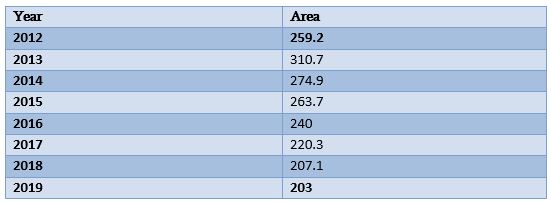
Source: National Statistics Office of Georgia
Table 1 shows that sown areas have been shrinking under the Georgian Dream’s rule.
In regard to the production of one-year crops, only wheat growth was up in 2019 whilst the production of corn, potatoes and vegetables decreased as compared to 2012.
Table 2:
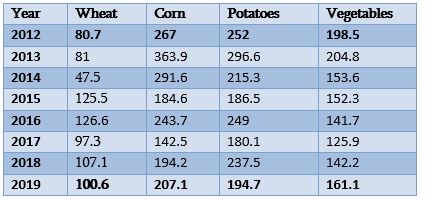
Source: National Statistics Office of Georgia
Of multi-year crops, grape production was much higher in 2019 as compared (doubled) to 2012 whilst the production of fruits and citrus has dropped.
Table 3: Multi-Year Crop Output
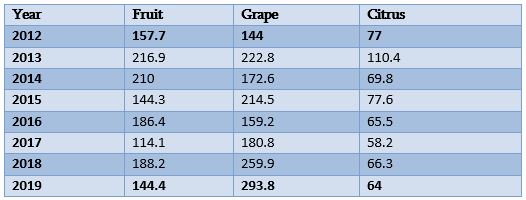
Source: National Statistics Office of Georgia
To measure progress in agriculture, livestock numbers are also important. In 2019, the number of cattle and pigs has fallen whilst the number of poultry, sheep and goats has increased.
Table 4: Livestock Number (Thousand)
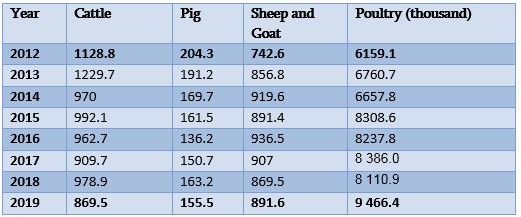
Source: National Statistics Office of Georgia
To measure advancements in agriculture, it is important to analyse animal husbandry output. In 2019, the production of meat and eggs increased whilst the production of milk and honey dropped.
Table 5: Animal Husbandry Output (Thousand Tonnes)
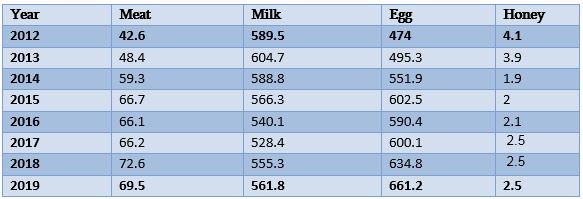
Source: National Statistics Office of Georgia
In summation, the agricultural sector decreased by 1.1% in 2019 as compared to the previous year. In addition, the agriculture to the GDP ratio dropped to 7.2%. In regard to progress in certain fields, the area sown with one-year crops shrank in 2019 as compared to 2012 as well as corn, potato and vegetable outputs have dropped. In addition, the yield of fruit and citrus together with cattle and pig numbers as well as the production of milk and honey have all decreased.
There is progress in grape production which has almost doubled since 2012. Wheat production increased by 19,900 tonnes (it was 80.7 thousand tonnes in 2012) and there are gains in poultry (by 3,307,000 - in 2012 it was 6,159,100) sheep and goat numbers. Meat (by 30,000 tonnes – it was 42,600 in 2012) and egg (by 160.8 million, it was previously 474 million) production has increased. Although, as compared to 2012, a threefold growth was not registered in 2019 in any of the aforementioned fields. As mentioned earlier, grape production has increased the most and has doubled.
Given the aforementioned factors, FactCheck concludes that Bidzina Ivanishvili’s statement is FALSE.








